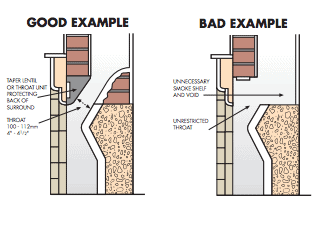Common Flue & Fire Problems
.
We are almost in December, and it’s getting colder, with more people starting to use their gas fires and stoves once again. This article looks at the specific issues, which can occur with flues. A flue is fundamentally a chimney or a pipe that removes combustion gases from a fire. Naturally hot air rises, and so a flue directs the gases upwards into the outside atmosphere. Not all flues need a chimney, some simply vent upwards to the outside environment directly from a fire.
The Up-Draft:
.
The combination of the height of the flue and the difference in temperature between the gases inside the flue, and the air outside creates the essential “up-draft”. The updraft is what essentially removes the gases from the fire, upwards into the outside environment. The hot gases inside the flue are lighter than the atmosphere outside, which causes the removal of the gases.
.
Common Problems:
.
A flue that is faulty may manifest it’s problems in a number of ways, including a slow or sluggish fire or an overall poor performance from the appliance. Below are some typical scenarios that you may encounter with a fire that has a “problem flue”
.
Scenario 1 – Some of the smoke from your fire appears to be filtering into the room, although there is no evidence of the smoke being blown back by the wind….
.
Possible Causes – This scenario is often down to an insufficient draft. You can easily do a test, open a door or window in the room where your problem fire is. If smoking into the room stops, then the trouble is usually down to air starvation.
.
If this is the problem, then you need to allow more air into your room without an inconvenient draft. The first thing to do is to see if it’s possible to reduce the amount of air flowing up the flue. By reducing the amount of air flowing up the flue will effectively reduce the need for so much air. An unnecessary smoke shelf inside a flue or chimney may be a reason behind the excessive demand for air by the fire.

.
Other factors, which can cause issues relating to a slow or sluggish fire include a fireplace opening that is too large, a fireplace opening, which is too high, or a part blockage or some sort of restriction of the flue. In a large number of cases, round-based chimney pots are fitted to square flues. This mismatch results in obstructive ledges, which may not be the only cause of the issues, but they can play a key part. If this is the case you should replace the pot with a correctly fitting one.
.
Scenario 2 – There is no up-draft whatsoever, but upon initial inspection there does not appear to be any obvious blockage. The lack of updraft is not effected by the wind, and is usually constant.
.
Possible Causes – The common cause here is often leaking joints in the flue. These should be checked. Sometimes a total blockage in the flue causes the up-draft to cease. It is important to keep a flue properly cleaned as soot deposits can build up. Ensuring you are burning the right fuel can help reduce the deposits – our wood burning guide provides essential advice on what wood you should be burning.
.
Scenario 3 – With wind in a certain direction, the upward draft stops or reverses, which causes smoke emission. The draft returns when the wind stops or changes direction.
.
Possible Causes – Air around a house creates high and low pressure. Low pressure can cause a down-draft that can cause smoke in a room. To test if you have low pressure, you can introduce some aromatic smoke to a room. If the smoke is drawn to the windows and doors in a room, then this will indicate low pressure outside. Effectively the smoke, the heat – is being drawn towards the lower pressure.
.
You can reduce this issue that low pressure brings, by fitting a draught-inducing cowl. You could also fit a throat restrictor, which would reduce the airflow, and increase the temperature inside the flue. Draught proofing doors and windows that are adjacent to the suction areas will also help.
.








